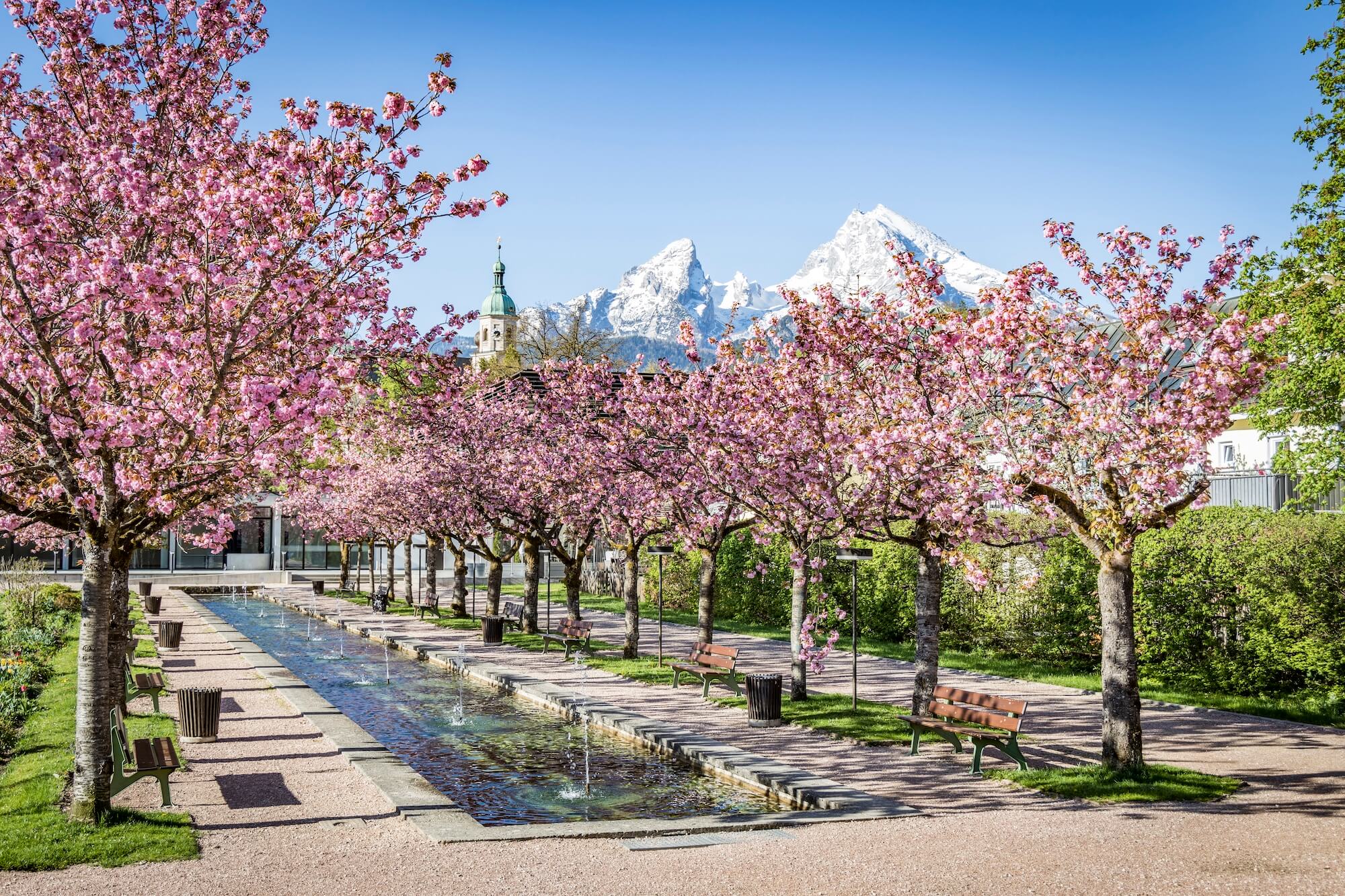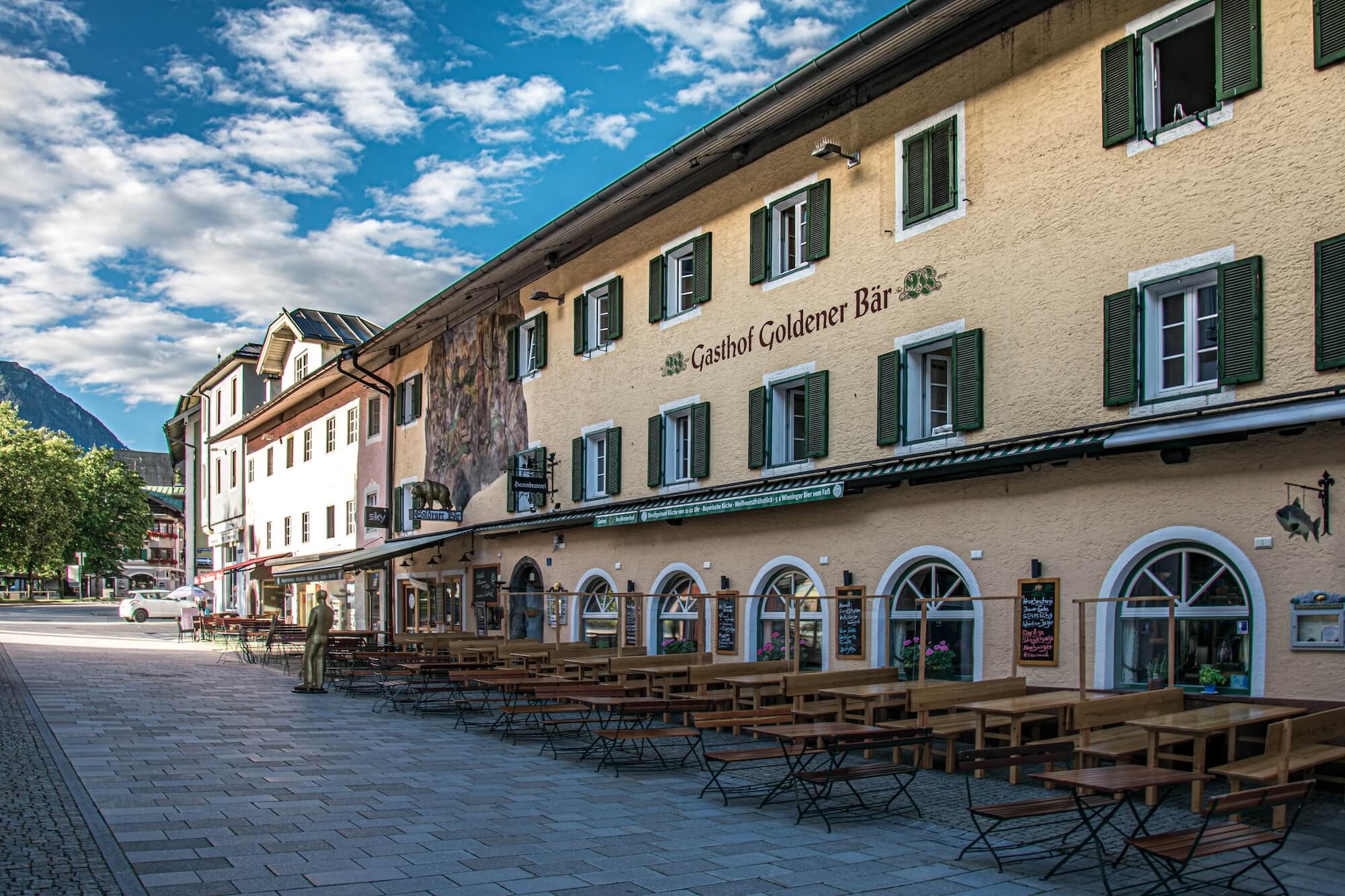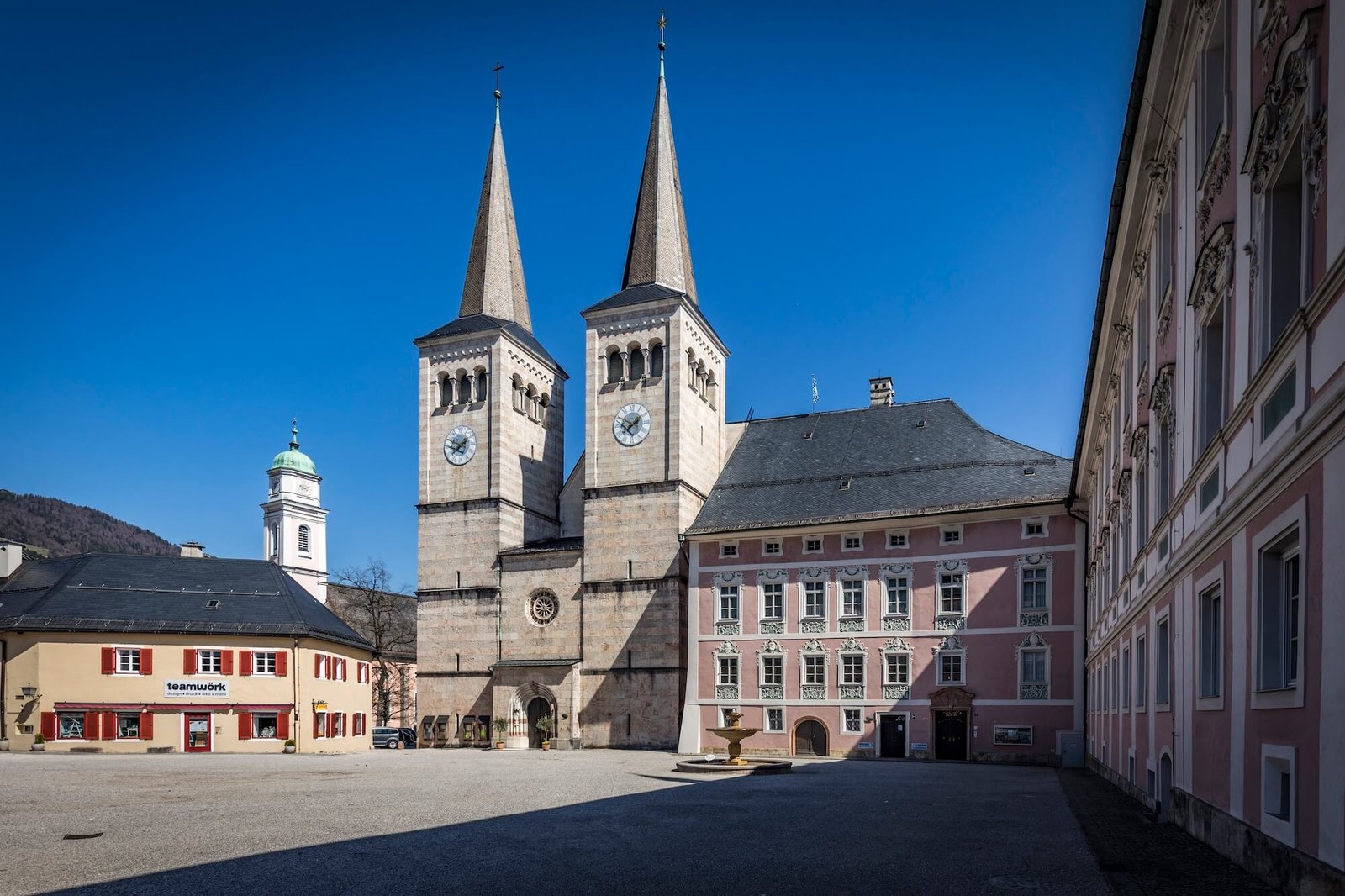
Self guided tour of Berchtesgaden
Discover what most visitors miss during their to trip to downtown Berchtesgaden.
An hour or two spent exploring on foot will give you a flavour of Berchtesgaden’s past under the rule of Augustinian monks, the impact of the Bavarian Royal Family and many fabulous photo opportunities.
- 1. Tourist Information and Congress Centre
- 2. The Tourist Garden
- 3. The Old Cemetery and Neighbouring Franciscan Church
- 4. Berchtesgaden’s Charming Pedestrian Zone
- 5. The Market Square
- 6. The Hirschhaus: Monkey Frescos and the Founding of Berchtesgaden
- 7. A Fairy-tale Donkey
- 8. Bier-Adam – The Oldest Inn in Berchtesgaden
- 9. Kaserer Haus
- 10. Castle Square and War Memorial
- 11. The Double Spired Collegiate Church
- 12. The Royal Palace
- 13. The Soleleitungs-Steg, a Royal Villa and fairy-tale prince Ludwig
- 13. The National Park Center “Haus der Berge”
1. Tourist Information and Congress Centre
It’s hard to miss this huge building clad in horizontal timber. Inside you’ll find the tourist information desk, Berchtesgaden’s main cinema, the main office for Berchtesgaden’s tourism board and a conference centre. Built in 1973, the timber cladding goes some way to mask the original 1973 concrete façade (!). To the front of the building you’ll find Sophies, a great spot to sit outside and enjoy a cool beer in the glorious Bavarian sunshine.
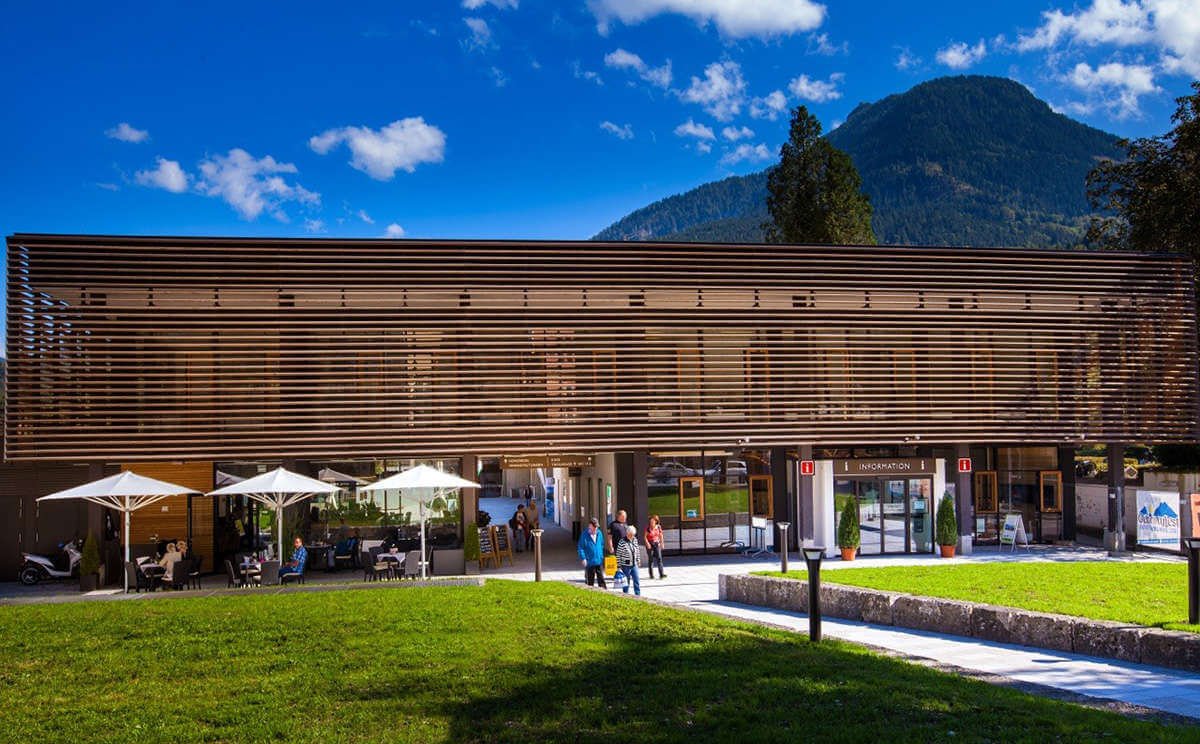
Inside the tourist information office, you’ll find decent public WCs, all sorts of information about the main sights of the region in multiple languages, daily German newspapers, free wi-fi and printing facilities.
Head down the stairs to reach the cinema, where you can try your hand at understanding Hollywood’s latest dubbed in German. Performance schedules can be found here.
2. The Tourist Garden
Known in German as the Kurgarten, the Tourist Garden is entered the through large metal gates towards the Hotel Edelweiss or via the underpass next to the tourist information office and was once part of the gardens that belong to the Royal Palace in Berchtesgaden. Today the Tourist Garden offers plenty of outside seating and is served by the excellent restaurant Sophies. If you’re fortunate enough to be visiting Berchtesgaden in Spring you’ll catch the stunning pink cherry blossom of the cherry trees that are neatly lined up on either side of the garden’s central canal. Here you can also enjoy musical concerts in the summer and views to the mountains (including the Kehlstein and the Eagle’s Nest atop its peak) year-round. A music schedule for 2020 can be found here.
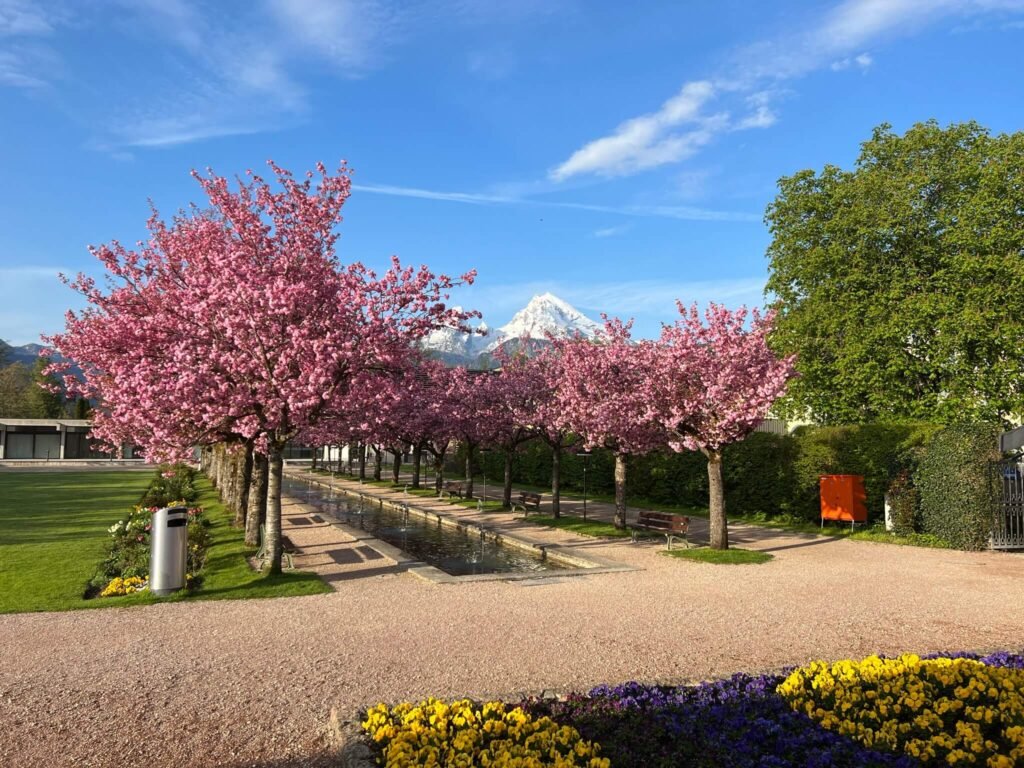
On your way out of the garden, take a look to the left-hand side of the entrance gates where you’ll see a concrete relief depicting one of Berchtesgaden’s farming traditions, Almabtrieb. This tradition celebrates the end of the region’s cattle herds’ summer out on the alms (the alpine meadows on the mountains) and marks their return to their farms for the winter. During this event many cattle are transported over nearby lake Königssee on specially adapted boats and are decorated with home-made wreaths and crowns, known in German as Fuikl.
3. The Old Cemetery and Neighbouring Franciscan Church
The white wall to the right of the Alpen Congress building is in fact the wall of Berchtesgaden’s oldest cemetery, established in the late 1600s. Further along you’ll see the adjoining church, a Franciscan church established by the ruling Provosts of Berchtesgaden in the late 1400’s. This gothic church is well worth a visit to admire the renaissance sculptures of Christ and the twelve apostles dating from the mid 1500s in the gallery. The altar is also noteworthy thanks to its unusual position – in the centre of the church.
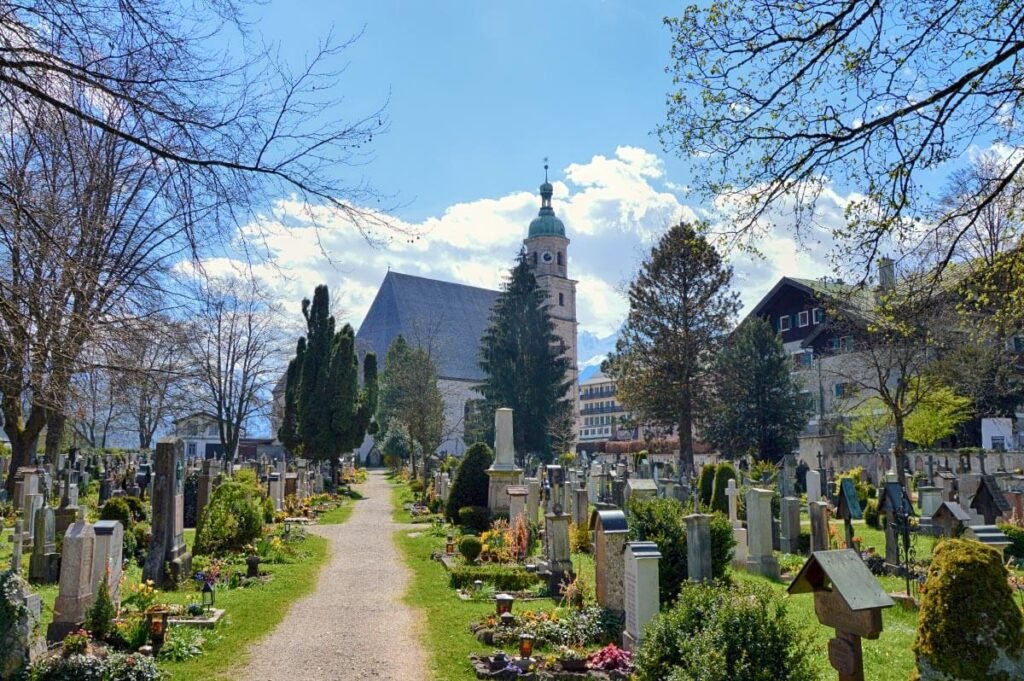
The white wall to the right of the Alpen Congress building is in fact the wall of Berchtesgaden’s oldest cemetery, established in the late 1600s. Further along you’ll see the adjoining church, a Franciscan church established by the ruling Provosts of Berchtesgaden in the late 1400’s.
This gothic church is well worth a visit to admire the renaissance sculptures of Christ and the twelve apostles dating from the mid 1500s in the gallery. The altar is also noteworthy thanks to its unusual position – in the centre of the church.
Personalities of note who are also buried in the old cemetery include Anton Adner, the once proclaimed oldest Bavarian (he died in his alleged 117th year of life), who was renowned for his skills carving and selling small decorated wooden boxes similar to those you can still find for sale in Berchtesgaden today. The museum Schloss Adelsheim has a marvellous selection of artefacts that illustrate this industry and those allied to it, further information and opening times can be found here.
Another (in)famous resident of the cemetery is Dietrich Eckart. This man was a nationalist and anti-Semitic writer in interwar Weimar Germany, eventually becoming mentor to the young Adolf Hitler. It is Eckart’s connection with Berchtesgaden that led Hitler to the area in 1923 and lay the foundation for both the evolution of the Nazi party and also the seizure of the area near to Berchtesgaden known as the Obersalzberg by the National Socialists once Hitler became Chancellor in 1933.
4. Berchtesgaden’s Charming Pedestrian Zone
Exiting the old cemetery, you’ll no doubt see the Hotel Edelweiss. One of the largest changes to the pedestrian zone in recent years was the replacement of the old Hotel Post with the 4* superior Hotel Edelweiss. The Hotel Post was the oldest in Berchtesgaden, functioning as a coaching inn for the post coaches and tourists making use of the post coaches. Although it dated from 1328, the Hotel Post was torn down in 2009 to make way for the Hotel Edelweiss that dominates the pedestrian zone (Fußgängerzone in German) today.
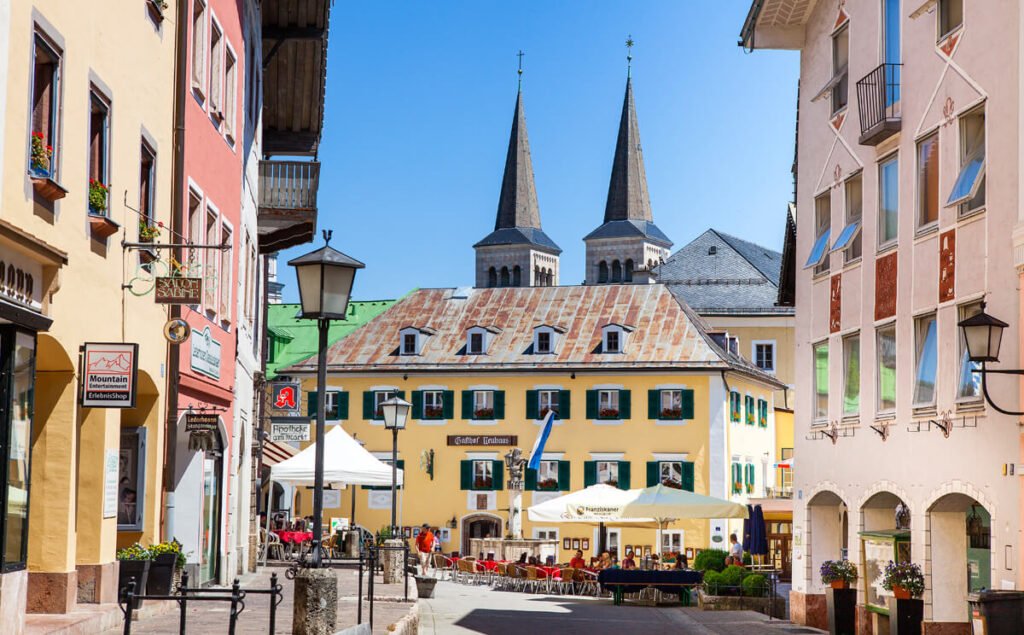
The cobbled streets that form Berchtesgaden’s pedestrian zone are lined with cafes, restaurants and numerous cultural gems. The best time to visit is either first thing in the morning, when you have the whole place to yourself, or on a summer evening with traditional Bavarian folk music playing in the market square.
Let’s start our tour by walking back past the tourist desk and crossing the road by the pink Aigner Lederhosen boutique. From here you’ll be able to see the rear of the Royal Palace if you look in the direction of the collegiate church’s twin spires. Keep on walking past the Aigner Lederhosen boutique and then head up the cobbled road to the left of Gasthof Neuhaus, once overflow accommodation for guests of the Royal Palace. At the top of this street you’ll have reached the market square.
5. The Market Square
The fountain you see in the market square, or Marktplatz, is the unknowing star of millions of visitor photos and postcards each year. Originally built in 1558, it has become something of a monument to Berchtesgaden’s relationship with the state of Bavaria. Atop the fountain sits one of the main symbols of Bavaria and the motif of the royal Bavarian Wittelsbach dynasty, the lion, added in 1677 by Maximilian Heinrich von Bayern (1621-1688) who was head of the Berchtesgaden monastery (Prince Provost) at the time.
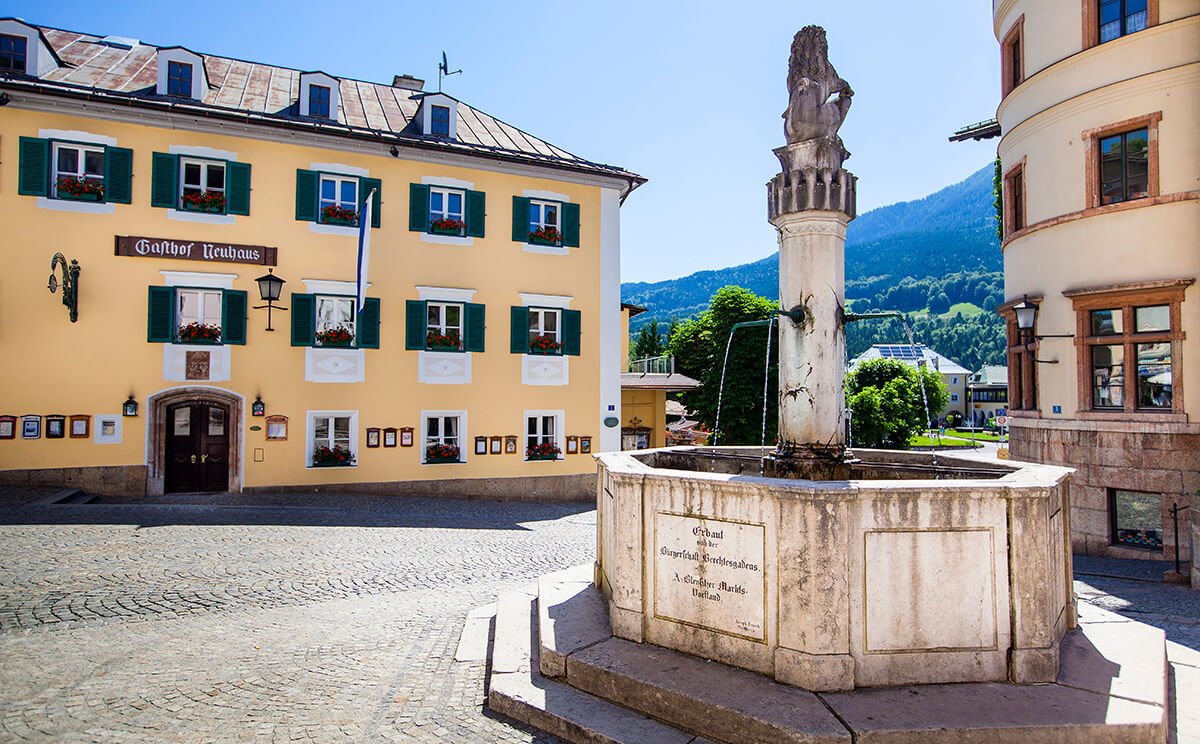
On base of the fountain you’ll see various inscriptions, including a dedication to the renovation of the fountain on the 50th anniversary of Berchtesgaden becoming part of Bavaria under King Maximillian II (1811-1864) in 1860.
The tower of the Hirschenhaus and wall of the Gasthof Neuhaus (the second oldest inn in Berchtesgaden, built in 1576) frame this compact market square where every Friday from 0800-1200 there is a local Farmers Market and, not to be missed, on Monday nights from June until September traditional folk music concerts take place from 1800.
6. The Hirschhaus: Monkey Frescos and the Founding of Berchtesgaden
Opposite the market square fountain, you’ll find the Hirschhaus, notable for its round tower and first-class examples of a style of external decoration known in German as Luftmalerei. Such paintings on the outside of homes became popular across southern Germany and the Tyrol in the middle ages, with the Hirschhaus believed to be the oldest example of Luftmalerei in southern Germany. In 1594 the Mayor of Berchtesgaden, Herr Labermaier, commissioned the building’s construction, followed in 1610 by the frescos to the exterior.
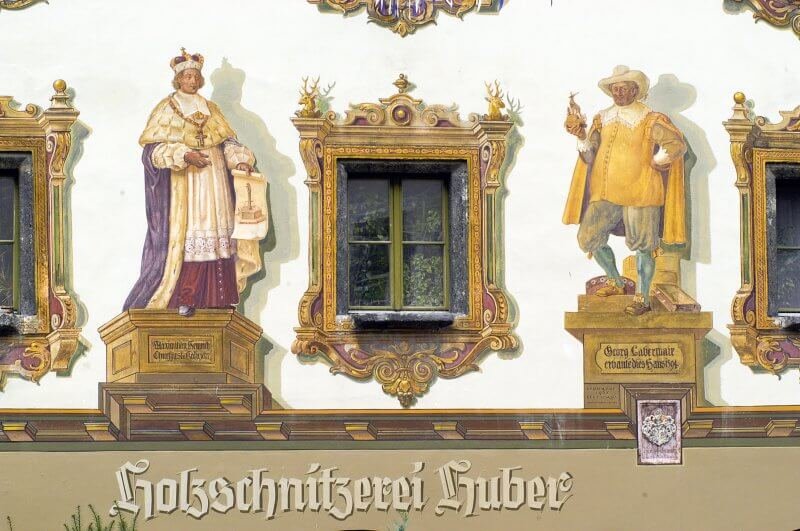
Two sides of the Hirschenhaus are decorated with Luftmalerei. The side you can see from the market square fountain depicts the main characters involved in the founding of Berchtesgaden: Irmengard and sons Berengard and Kuno. The scene is best viewed from the other side of the square, where you’ll be able to see the paintings of Irmengard, Berengard and Kuno, along with the roman numerals MCXX to mark the year of Berchtesgaden’s founding – 1120.
Further down the façade we have Maximilian Heinrich von Bayern (1621-1688), who was the Duke of Bavaria and from 1650 also head of the monastery in Berchtesgaden and responsible for upgrading the market square fountain in 1677. Hence, he is depicted with the fountain on his scroll and corresponding date. To the right we have an image of Georg Labermaier himself, commissioner of the Hirschenhaus and its frescos.
The other side of the Hirschenhaus also has superb Luftmalerei. Head back down the cobbled street past the Hirschenhaus tower and turn right past the Doll café to find them. On first inspection the frescos appear normal enough, but look closer and you’ll see that man has been replaced by apes. It’s worth remembering that at the time of painting, the monks of Berchtesgaden’s monastery were all powerful. In these times religious iconography used the ape as the symbol for man who has sinned and hence, on first inspection, the fresco is in fact a warning of man’s weaknesses.
Window by window different sins are explored:
The top left window warns against merriment (the couple are leaving a party), vanity (the female carries a mirror) and improper relations (forbidden fruits below the image).
Moving to the second window (top centre) we have an orchestral scene – less the conductor. The sense of confusion and disharmony amongst the members of the orchestra is a loosely veiled warning of what might happen without the people’s real conductor, the Church.

The top right window turns our attention to over-indulging. The figure with human mask sat atop a barrel depicts Bacchus, the roman god of wine and ecstasy, and this image warns against drunkenness and drunken behaviour.
Bottom left we are presented with a money lender taking advantage of those who have indulged and over-spent, watched over by the tax collector positioned underneath the window.
The bottom right window shows two male figures quarrelling over a game and thus representing idleness and the evils it brings. Their sin is amplified by the woman and child working hard to the left of the image and, again, watched over by the elderly woman who is also toiling, positioned underneath the window.
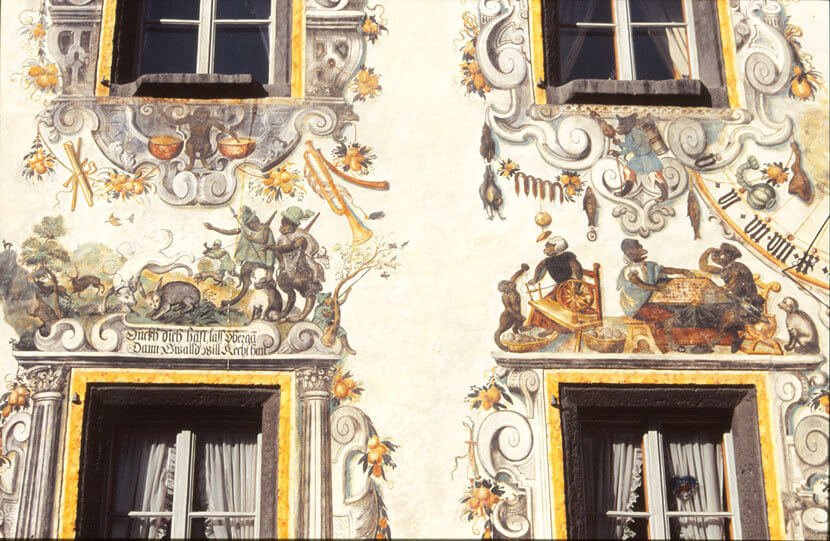
The centre bottom window is a hunting scene, reminding viewers that hunting was the reserve of the ruling classes and that poaching was strictly forbidden. The apes are hunting the hare and this image, plus the message below it, perhaps hints at the true purpose of the windows. The Bavarian text roughly renders to, “duck down, little hare, and let it pass, since force will always want its own way”.
Whilst the apes depicted the weakness of man in the previous windows, perhaps they now in fact represent the ruling classes, with man assuming the role of the hare. This tallies with the thought that Herr Labermaier in fact commissioned the fresco not to warn the people of the town, but to highlight that the ruling classes from the monastery were in fact the perpetrators of all the sins depicted; no doubt their depiction as apes in full public view was an irresistible (and everlasting) private joke.
One alternative story (perhaps spread by the monastery?) that explains the ape faces is that the scenes were originally painted with normal faces to depict the lives of the Labermaier family, but were later repainted by artist after the Labermaier refused settle the final invoice for the work.
7. A Fairy-tale Donkey
Continue along the street past the Monkey façade of the Hirschenhaus and you’ll come face to face with a rather peculiar fountain on your left-hand side.
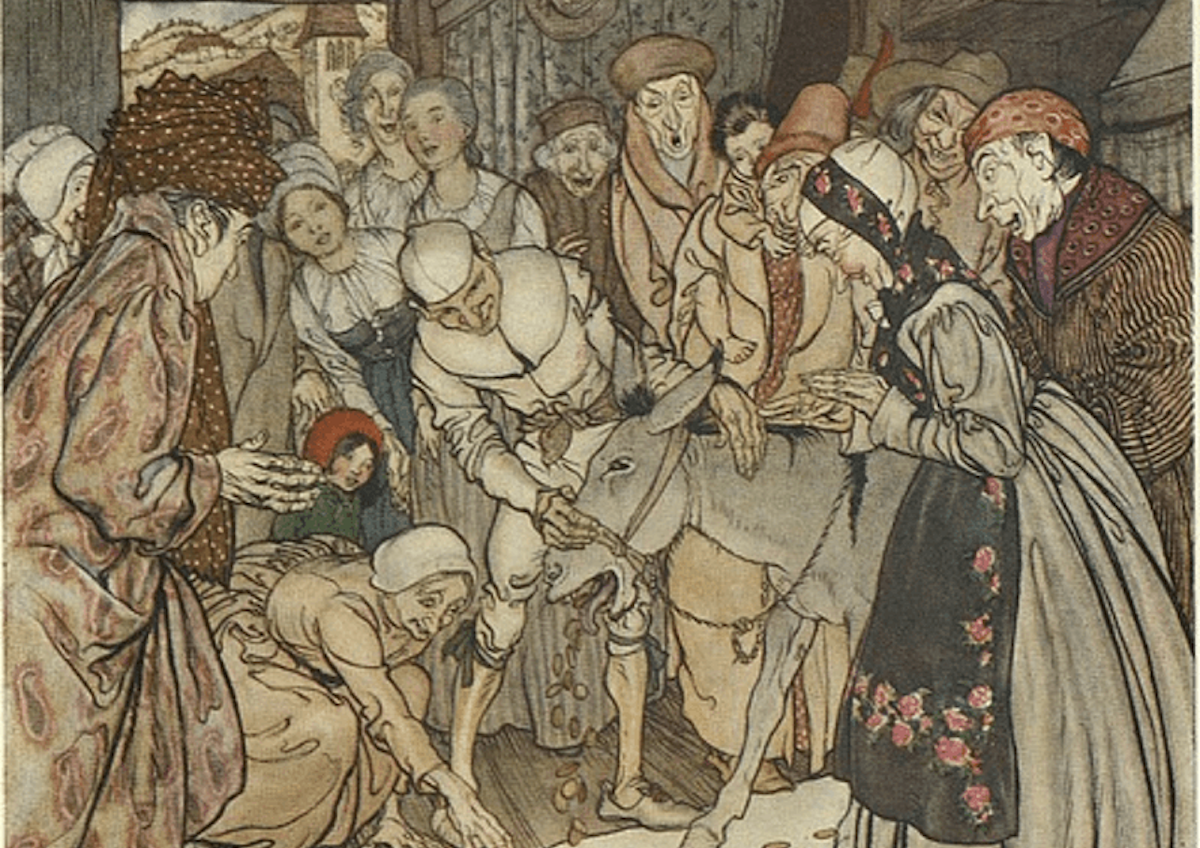
A boy holds a donkey under his arm that is producing gold from both its mouth and rear. It’s a reference to the classic German fairy-tale Tischlein-deck-dich, written by the (yes, you guessed it) Brothers Grimm. In the story a disappointed father banished his sons from the family home and on their travels their story becomes intertwined by enchanted items, amongst which is a donkey that can produce gold from both front and back upon hearing the command “Bricklebritt!” Why not give it a try?
8. Bier-Adam – The Oldest Inn in Berchtesgaden
At the end of the street you’ll find yourself in the Weihnachtsschützenplatz, the Winter Shooters’ Square. Weihnachtsschützen (Winter Shooting) is a Berchtesgaden tradition dating from 1666 where black powder arms (Handböller) are fired at Christmas and New Year to ward off evil spirits. The square hosts many events throughout the year including folk music on summer evenings, a table at Café Forstner or Hotel Edelweiss offers a first-class vantage point.
Turning right at the square you’ll catch a glimpse of another superb example of Luftmalerei decorating the façade of Berchtesgaden’s oldest inn, the Bier-Adam.

Historically, the influence of the ruling monastery also extended to the drinking habits of Berchtesgaden’s population. Until the middle of the 17th century, it was mainly wine that was drunk in Berchtesgaden due to the monastery’s ownership of many vineyards.
Berchtesgadeners were not completely without beer, however, as research shows us that in 1546 there was an independent beer business in the Berchtesgaden market place – this was in fact the forerunner to the business that is today known as the Gasthaus zum Bier-Adam, making it is the oldest inn in Berchtesgaden.
Today the oldest inn in Berchtesgaden serves typical Bavarian delicacies and international specialties alike and offers another superb vantage point to watch events taking place in the nearby Weihnachtsschützenplatz. The Luftmalerei decorating the Bier-Adam’s façade hints at the previous clientele of the inn…
9. Kaserer Haus
Opposite the Bier-Adam is the Kaserer Haus. The Kaserer family made their fortune by exporting the wooden handicrafts made by the local population and by 1607 had amassed a fortune great enough to have the house you see before you built.
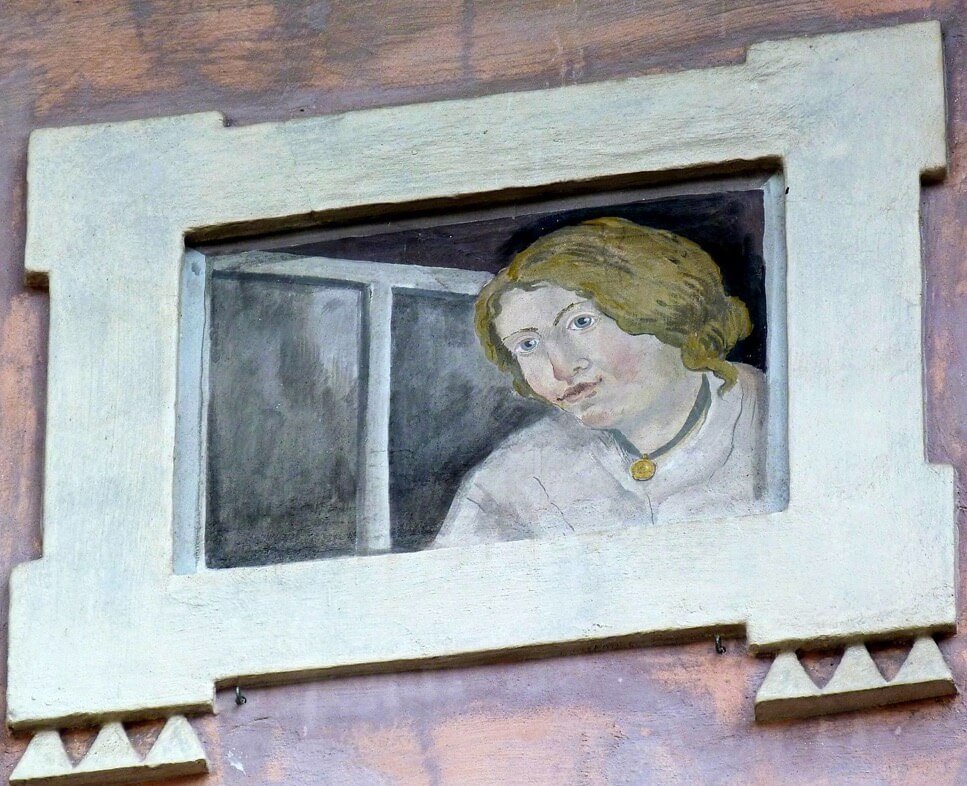
On the face opposite the Bier-Adam you might be able to see a false window, painted on the plaster work complete with someone looking out of the window. A recent custodian of the building wanted to convert a room into a bathroom but needed to block off the window, contrary to the fact the building held a protected monument status. To cover up this crime the window was quietly blocked off and re-instated…in paint.
10. Castle Square and War Memorial
Follow the cobbled street along past the Kaserer Haus and Market square to reach the arches that lead into the Castle Square. After the first arch you’ll pass the Heimatwerk Berchtesgaden shop on your left where you can buy wooden handicrafts that the population of Berchtesgaden have crafted for centuries to supplement their incomes. Our recommendations are the classic wooden Christmas tree decorations and painted wooden boxes – they make a perfect sustainable gift or memento. More information, opening times and online shopping can be found here.
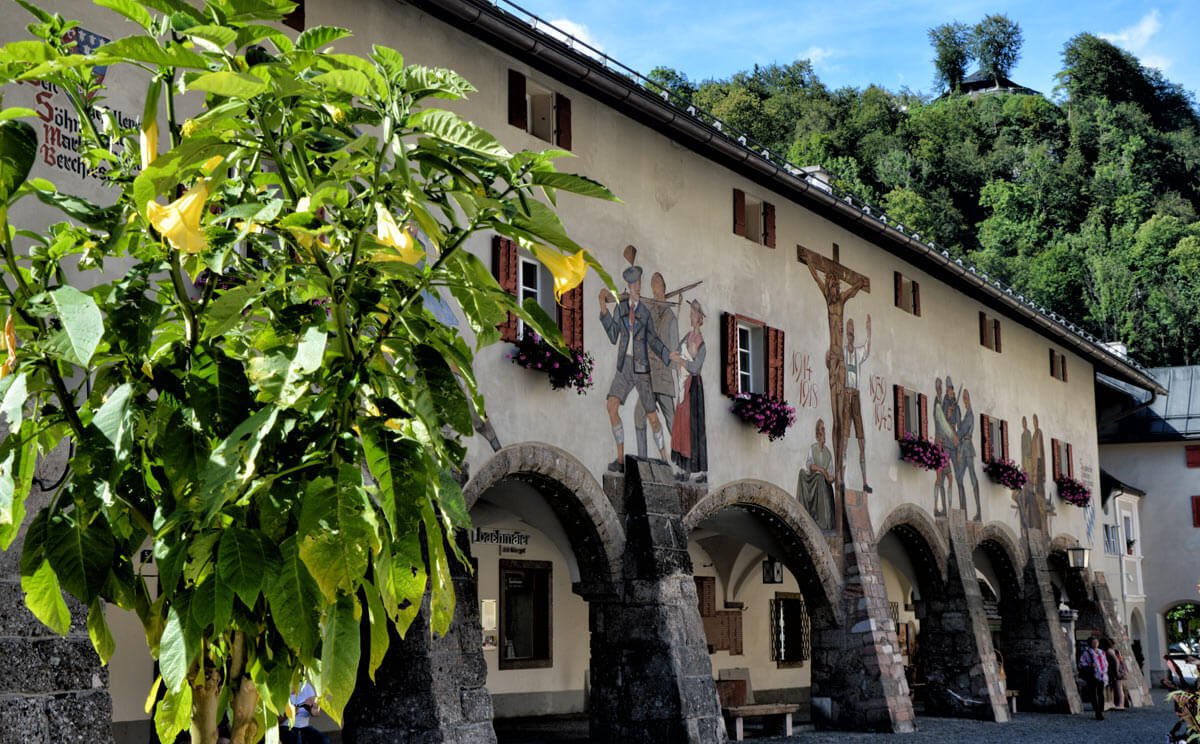
Passing under the next arch you enter the Castle Square where the double spired collegiate church and beautifully painted walls of the Royal Palace stand proudly. The fountain in the centre of the square is a fairly recent addition, installed in 1960 for the 150th anniversary of Berchtesgaden becoming part of Bavaria.
Make your way to the fountain in the centre of the square to gain an overview of the impressive war memorial fresco painted in 1929 by Kempten artist Josef Hengge (1890-1970). This arcade was once an agricultural store and stables but by the time of the Royal Palace opposite, had been converted into part of the castle square.
In the aftermath of the First World War, Hengge painted a series of five frescos dedicated to Berchtesgaden’s 89 sons who fell in the First World War. From left to right, the frescos depict: assault on the enemy, farewell to the fatherland, the belief that god is with those who fight, homecoming and finally mourning the fallen.
It is worth noting that what you see today is a reproduction of the originals, painted by Hengge in 1952. Under orders of the victorious allies, the original paintings were painted over at the end of the Second World War. Hengge made two significant changes in 1952: the dates of the Second World War were added to the central work and the scene to the far right was changed from its original depiction of a German soldier triumphing over Russians to a scene of mourning.
11. The Double Spired Collegiate Church
Turning right from the war memorial you’ll find yourself face to face with what is, aside from the Watzmann mountain, the best-known icon of Berchtesgaden: the double spired Collegiate Church.
The church was completed in the late 12th century and originally resembled a basilica (rectangular hall), despite the later Italian-Lombardian style double spires. The most prominent piece of the original basilica is the entrance porch. The church is open to the public so why not take a look at the beautiful stonework of the inner entrance porch and make your way inside.
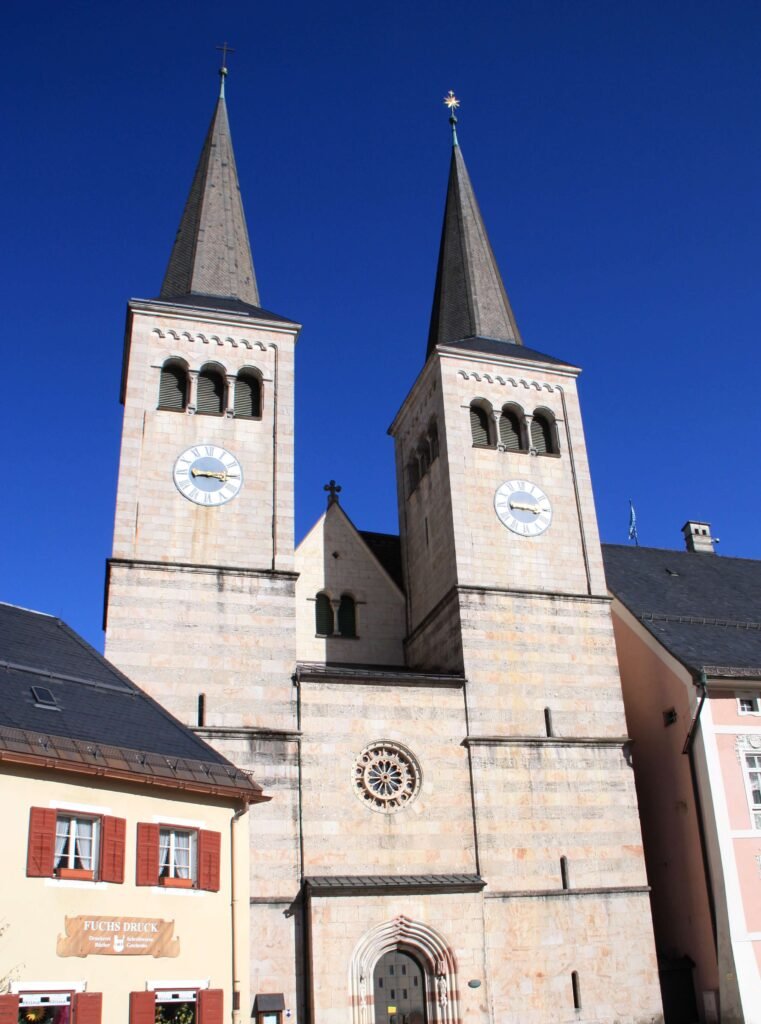
Upon entrance you’re in for a treat, as the church still possesses its original gothic chancel (immediate surroundings of the altar) dating from the 13th century and a magnificent high alter dating from 1669. The gothic choir stalls are rumoured to have taken a father and son from Berchtesgaden some 30 years to construct, completing their work in 1440.
Highlighting the link with the former monastery and subsequent royal palace you’ll see the ornate (rococo style) private oratories up to the right-hand side of the church where the ruling classes could pray without having to mingle with the masses. The oratories even had communicating passages to the adjacent monastery/royal palace to further minimise the risk of having to mingle with the peasants of Berchtesgaden.
Lower down on the right-hand side there is a grand portrait of Josef Konrad von Schroffenberg, who was the very last ruling monk (Prince-Provost) of Berchtesgaden. That the victory of Napoleon’s forces over Salzburg in 1803 made it clear that Berchtesgaden would also face occupation is well known, but what is far less well known is that fact that the commander of Napoleons’ troops in Salzburg, Moreau, was in fact a school friend of von Schroffenberg. A meeting between the two after the fall of Salzburg guaranteed the peaceful occupation of Berchtesgaden in 1803 and the stationing of Moreau’s best troops in the town to protect against pillage by other French units.
12. The Royal Palace
Exiting the collegiate church, the entrance to the Royal Palace is to your left. Built in the 1100s, the Royal Palace in Berchtesgaden in fact started out life as the Augustinian monastery that functioned as the power base for the ruling Provosts (head monks) of Berchtesgaden up until their ejection courtesy of the Napoleonic wars and the town’s integration into Bavaria in 1810.
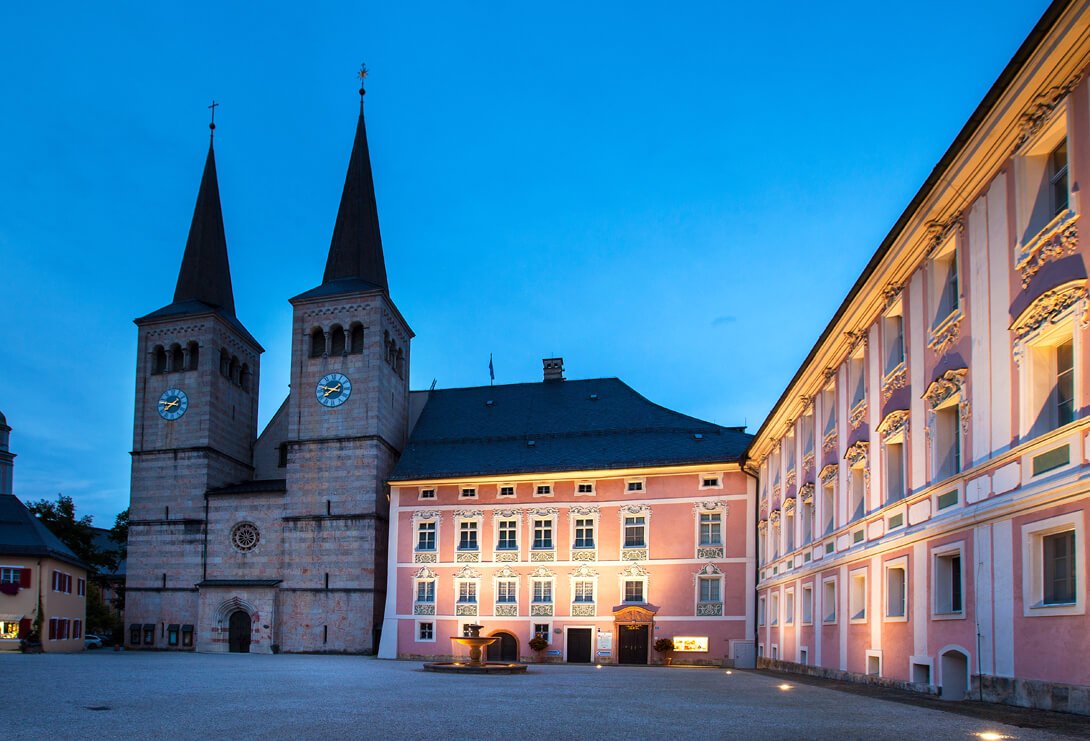
The first monastery, a modest gothic structure, was consecrated in 1122, but the structure was enlarged and refurbished as the Provost’s power grew. From 1818 onwards, once refurbished to their tastes, the Bavarian Royal Family took the former monastery as their summer palace. Believe it or not, the palace is still an official residence for the House of Wittelsbach.
Today you can visit the palace and tours are conducted in English, subject to sufficient interest. Further information can be found HERE. Your best bet is to visit in June, July, or August. Entering through the arch in the corner of Castle Square and paying your entrance fee you’ll pass into the castle cloister where the original 12th century stone columns and local red marble flagstones remain. If you look closely, some of the flagstones (now hanging on the walls) are actually the memorial stones of former Provosts, the oldest of which dates back to 1278.
Within the cloister, scenes from the Bible decorate many of the pillars and the compact original chapel to the monastery (the Martinskapelle) echo the faith of those who founded the palace; the large Lombardian lion sculpture (the symbol of Bavaria) reminds us of the palace’s last custodian. Enter here to begin your tour of the various armouries, reception rooms, dining rooms, trophy halls and also the chance to see Prince Rupprecht’s (1869-1955) apartment.
13. The Soleleitungs-Steg, a Royal Villa and fairy-tale prince Ludwig
The Bavarian Royal Family took Berchtesgaden as their summer residence from 1818 to 1918 and made very good use of the Royal Palace in the centre of Berchtesgaden. It was Maximillian II (1811-1864) who, in 1849, considered the Palace not in the style of a Royal Family’s summer retreat and commissioned the construction of an additional country residence for the family in Berchtesgaden. The result was the Royal Villa (Königliche Villa), built between 1849 and 1852 in the Florentine style. It was here that Maximillian, his wife Marie of Prussia and their sons, Otto and Ludwig II (the fairy-tale castle builder himself), would spend their summers up to Maximillian II’s death in 1864.

To reach the villa from the Royal Palace it’s worth taking the Soleleitungssteg, a pathway that takes you along the former route of a brine pipeline that moved brine from the Berchtesgaden salt mine (see our guide and tours) to the facility at neighbouring Bad Reichenhall for processing. From the Royal Palace, head across the Castle Square and under the arch decorated with a sun dial. You are now in the town hall square where you need to turn left and head up the cobbled street, the Doktorbergstraße. The Doktorbergstraße heads quite steeply uphill for five minutes or so and bears gently right, taking you into one of Berchtesgaden’s residential areas, where you’ll see the old Gramiller wood carving shop to your left-hand side and the steps that lead you up onto the Soleleitungssteg.
After a few minutes walking along through the trees you’ll reach the plaque commemorating the chief engineer of the brine pipeline, Georg von Reichenbach, who supervised the construction during the years 1816-1817. This is also where the stunning timber walkway begins that offers panoramic views over Berchtesgaden’s rooftops.
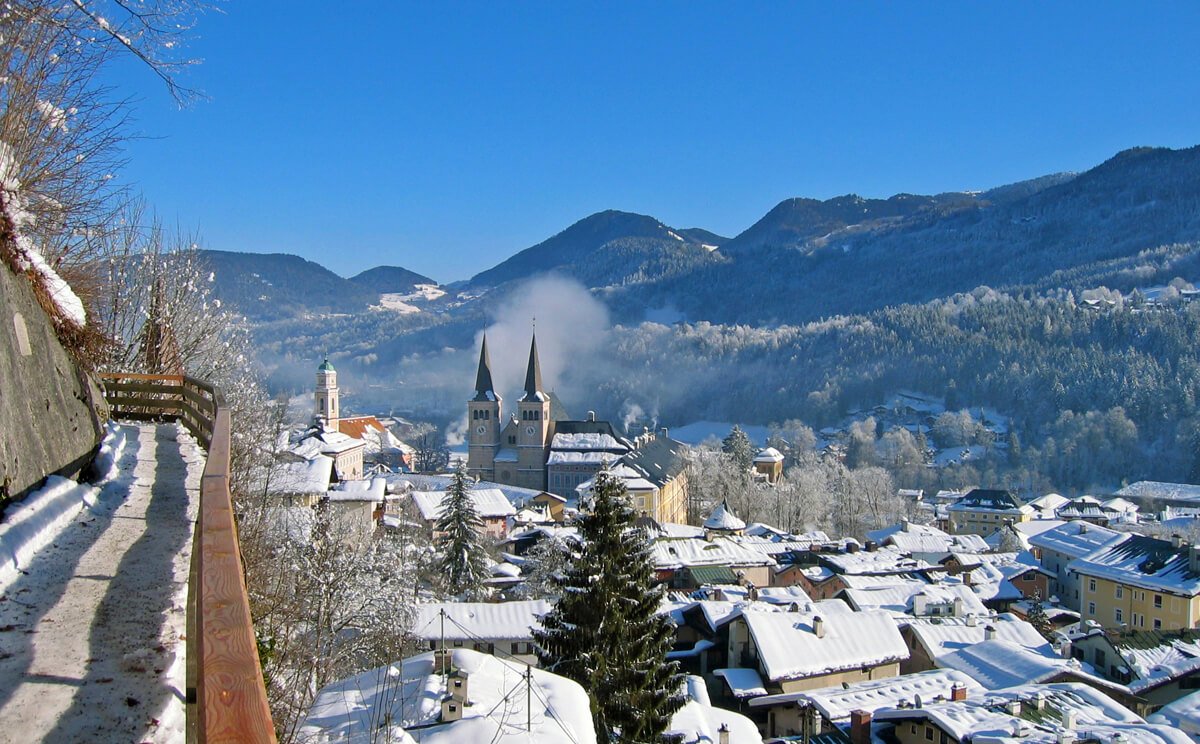
After the timber walkway you’ll pass some more residential buildings and reach the Klavarienberg chapel, built in 1760 and renovated in 2011. This is illuminated at night and also offers another super vantage point over the town. The Soleleitungssteg then winds through the trees until the rear of the sprawling Royal Villa comes into view down the hill on your left-hand side. For a good overview of the Villa you’ll need to follow the Soleleitungssteg to the hotel Kronprinz and then take the Kälbersteinstraße left and down to the main frontage of the Royal Villa.
Approaching the Villa, you’ll first see the large rear wing of the villa that was converted into flats in the 1980s and two towers where one can find unique holiday flats with views of the Watzmann Mountain. Walking down past the main frontage of the Royal Villa you’ll no doubt spot the Mount Everest Restaurant occupying what was once a sun promenade at the foot of the Villa. Looking up at the building you’ll see its distinctly non-Bavarian Italian Classic facades in timber and a carvings depicting Maximillian II and his spouse Queen Marie.
Opposite the Royal Villa is the Luitpold Park, dedicated to Prince Luitpold (1821-1912) who was very happy to spend time in Berchtesgaden thanks to his love of hunting. Descend the pathway opposite the Royal Villa and head towards the sound of running water. Here you’ll find a statue of Luitpold in full hunting regalia.
13. The National Park Center “Haus der Berge”
Making your way from the Luitpold statue through the Luitpold park down towards the main road, you’ll find yourself on the Hanielstraße. Our next and final stop is the National Park Centre, which is reached by turning right and walking uphill along the Hanielstraße towards the roundabout, where you’ll come face to face with the gigantic modern timber and steel structure that is the National Park Centre, or Haus der Berge.
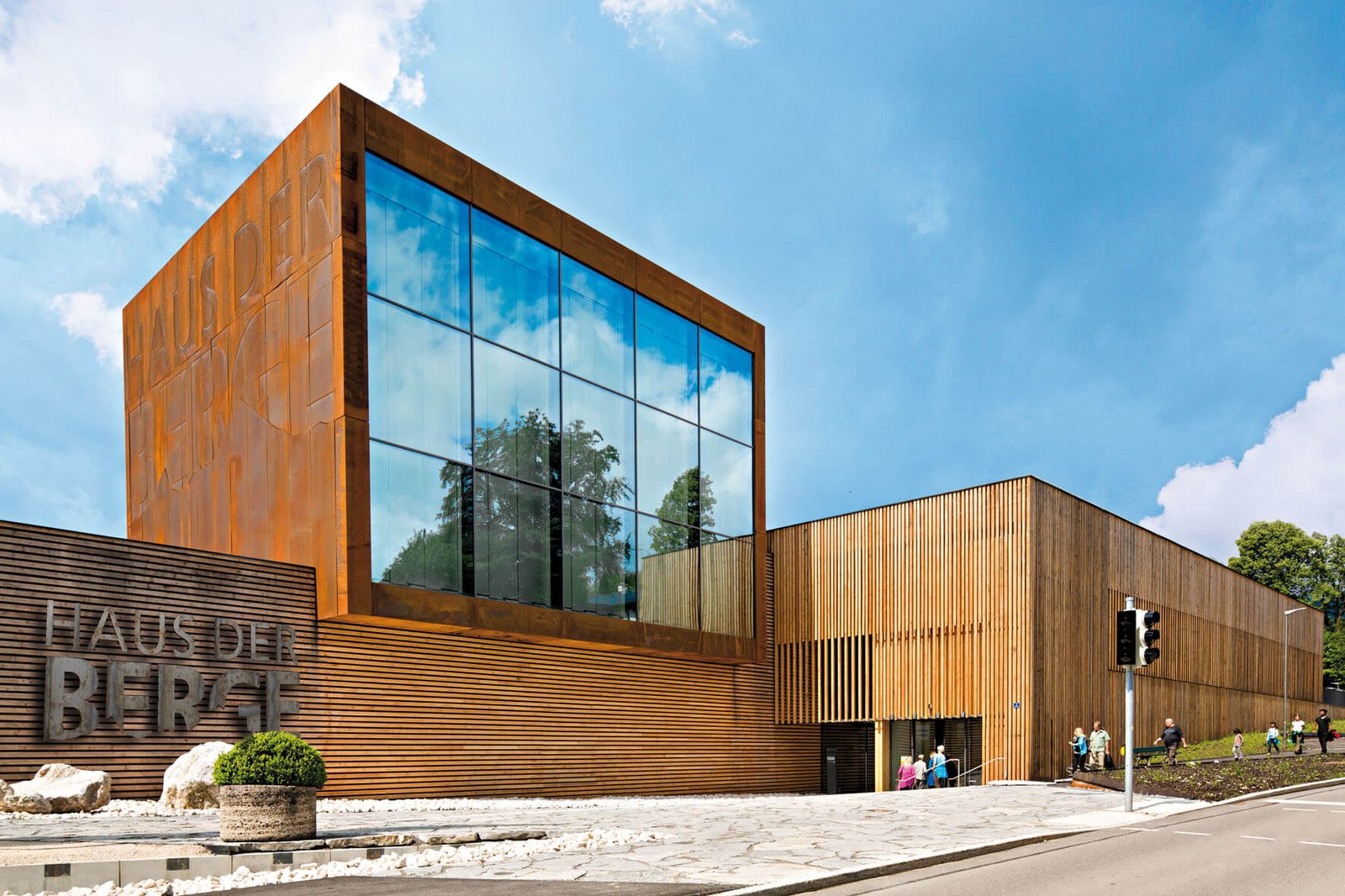
In 2009 the former Berchtesgadener Hof hotel was knocked down to make way for the bold creation you see before you today. Prior to 1936, the Berchtesgadener Hof hotel had been the Grand Hotel Auguste Victoria, an alpine hotel extremely popular with visiting royalty. In 1936 the National Socialist administration bought and remodelled the hotel, renaming it the Berchtesgadener Hof.
The Berchtesgadener Hof was used it to house dignitaries visiting the National Socialists’ second seat of power up on the Obersalzberg, including Duke and Duchess of Windsor, British Prime Minister Neville Chamberlain, and former British Prime Minister David Lloyd George. High-ranking Nazis such as Josef Goebbels, Heinrich Himmler, and Joachim von Ribbentrop also stayed here, as did Eva Braun before she moved into Hitler’s home on the Obersalzberg, the Berghof.
After the destruction of the former Berchtesgadener Hof in 2009, the foundation stone of the Haus der Berge was laid in 2010 and the centre finally opened in May 2013. Inside there is an information centre, education centre and an outdoor adventure area. The two highlights are the vast 3D model of the National Park showing many breath-taking hiking routes and the 900 m² “Vertical Wilderness” exhibition that depicts the rich variety of wildlife that call the Berchtesgaden National Park home.
To round off your tour of the town there’s nothing better than a slice of cake and coffee (or Schnapps) on the terrace of Spiesberger’s Alpenküche at the National Park Center, overlooking the Watzmann mountain. Guten Appetit!
